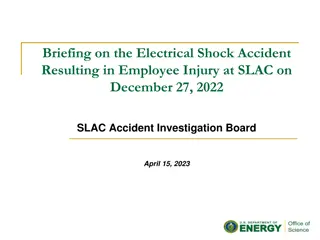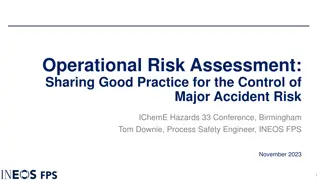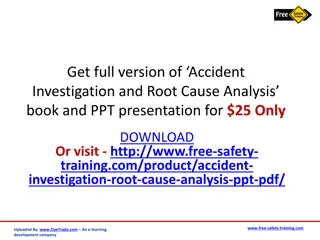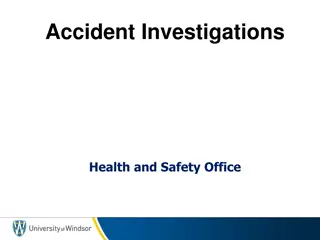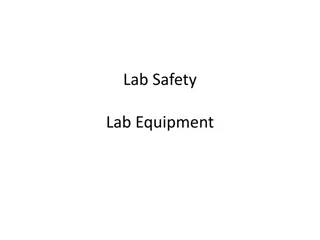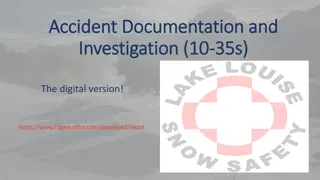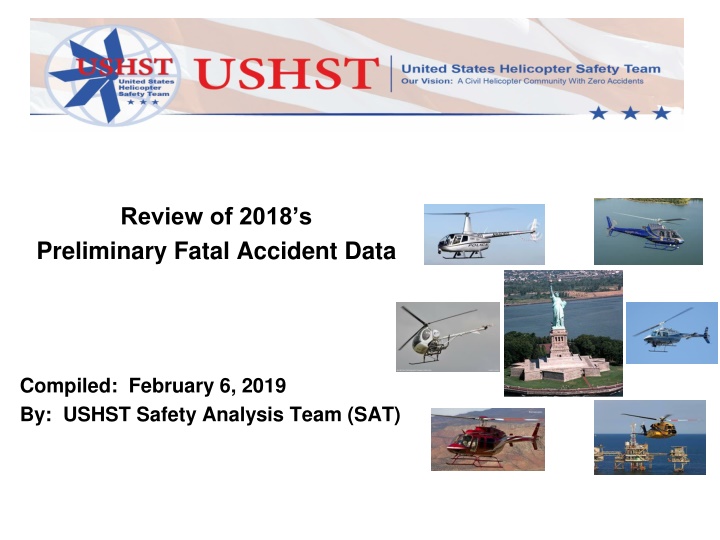
Analysis of US Helicopter Fatal Accidents: 2018 Data Review
"Explore the increase in US helicopter fatal accident rates in 2018, with a focus on occurrence categories and the rise in Low Altitude Operations incidents. Discover insights from the USHST Safety Analysis Team and interventions to address wire strikes."
Download Presentation

Please find below an Image/Link to download the presentation.
The content on the website is provided AS IS for your information and personal use only. It may not be sold, licensed, or shared on other websites without obtaining consent from the author. If you encounter any issues during the download, it is possible that the publisher has removed the file from their server.
You are allowed to download the files provided on this website for personal or commercial use, subject to the condition that they are used lawfully. All files are the property of their respective owners.
The content on the website is provided AS IS for your information and personal use only. It may not be sold, licensed, or shared on other websites without obtaining consent from the author.
E N D
Presentation Transcript
Review of 2018s Preliminary Fatal Accident Data Compiled: February 6, 2019 By: USHST Safety Analysis Team (SAT)
Purpose of Review U.S. helicopter fatal accident rate per 100K flight hours increased in 2018 0.6 in 2017, increased to 0.72 in 2018 20% increase Safety Analysis Team (SAT) tasked to research what may have contributed to the increase Conclusions are preliminary All 24 fatal accidents from 2018 are still under NTSB investigation
Occurrence Categories Initial task: Compare how occurrence categories for events in 2018 compared to USHST s analysis of fatal accidents from 2009-2013 Occurrence categories define what happened In USHST s detailed analysis of fatal accidents from 2009-2013, there were 3 leading occurrence categories Loss of Control Inflight (LOC-I) Unintended Flight into IMC (UIMC) Low Altitude Operations (LALT) Together, accounted for 50% of the fatal accidents analyzed (52 of 104)
How was 2018 different? Low Altitude Operations (LALT) fatal accidents increased in 2018 33% of the fatal accidents in 2018 as compared to 15% from 2009-2013 LALT definition by CAST/ICAO Common Taxonomy Team (CICTT) collision or near collision with obstacles/objects/terrain while intentionally operating near the surface (excludes takeoff or landing phases). In other words, the aircraft hit something while operating low How many potentially involved wires and supporting structures? Preliminary data suggested involvement in 7 of 8 LALT fatal accident in 2018 Would mean 29% (7 of 24) of fatal accidents in 2018 related to wires Accounted for 20% of 2018 s fatalities (11 of 55)
Additional USHST Analysis on Wire Strikes USHST developed 117 total intervention strategies in their analysis work of the 2009-2013 fatal accidents. Only the top 25 quantitatively ranked interventions were selected for action (due to limited USHST resources) Top 25 interventions were later consolidated to 22 and written into detailed helicopter safety enhancement (H-SE) plans (available at ushst.org) Implementation of the H-SEs began in 2017 13 of the top 25 interventions developed into H-SEs addressed problems identified in LALT fatal accidents Some additional interventions addressing wire strike fell below the USHST s cut line for implementation. The USHST may pursue some of these at a later date Entities outside the USHST are welcome to pursue them if they have the resources available
Wire Strike Interventions Below USHST s Cut Line FAA and industry develop improved on-board wire strike protection devices. The intent is to expand the capabilities of currently available WSPS kits and potential new technologies. Ranked 28thof 117. Industry to work with owners of power and distribution line databases to fuse relevant and up-to-date wire data into pilot planning and enroute tools. Ranked 39thof 117. Industry continue to develop more accurate, low cost, lightweight wire detection systems for installation on the aircraft. Ranked 50thof 117. Industry to investigate ways to increase visibility of all wires in areas where there is a known high volume of helicopter traffic. Ranked 55thof 117.
Wire Strike Interventions Below USHST s Cut Line (continued) FAA and industry work together on research of vision system technologies to display and alert for airborne hazards (such as wires). Ranked 77thof 117. Industry develop/adapt/certify a wire strike protection system for light helicopters (such as Robinson, Schweizer, Enstrom, Helicopteres Guimbal, etc). Ranked 98thof 117. FAA promote more wire marking/better identification means for wires/cables by engaging with the various industries involved in suspending wires/cables. Ranked 113thof 117.

